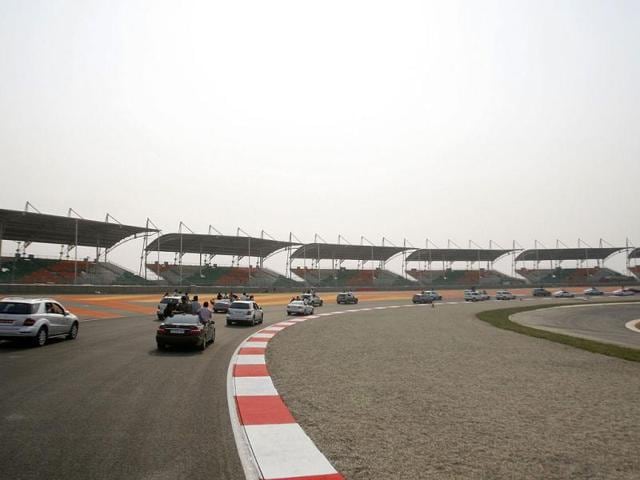The race is not over
The Formula 1 event was a good example of a private-public venture. But when will we see such enthusiastic partnerships in building hospitals in UP?, writes Rajdeep Sardesai.
Two of the country’s biggest sports events in the last 12 months mirror two Indias. The Commonwealth Games (CWG) in October 2010 was organised by an older India of the cosy neta-babu nexus. The Formula 1 (F1) Grand Prix was staged by a newer India through a happy marriage of local private entrepreneurship and global business. The CWG, blighted by a string of corruption allegations, are seen to have dented India’s image. Formula 1, on the other hand, is seen to have only confirmed India Inc’s arrival on the world stage. So has the newer India of corporate and showbiz power scored over an older India of political and bureaucratic largesse?

Well, yes, and no. There is little doubt that the F1 event was a spectacular success in terms of event management.
Barring the stray dog who wandered on to the race track, and a rock concert that never was, the event ran with clockwork precision. All those who attended the race were unanimous in their praise of the arrangements and the drivers too seemed pleased. Certainly, we didn’t have the embarrassment of unclean toilets, missed deadlines and last-minute construction that marred the CWG build-up.
Whereas the CWG was organised by a vast army of politicians, bureaucrats and sports officials, F1 was driven by a small team of management professionals. For the CWG organisers, the F1 event was an opportunity to distribute political patronage to friends and clients. For the F1 organisers, the race was a business opportunity aimed at brand-building and profit-making. The money spent on the CWG came from the ubiquitous taxpayer, with the result that there was little accountability in the process. The money spent on F1 came from publicly-listed companies who needed to show tangible benefits to their shareholders.
And yet, it would be simplistic to see the success of F1 as a sole triumph of private enterprise. Let's be honest, organising an F1 in Greater Noida would not have been possible without the solid support of the Uttar Pradesh chief minister, Mayawati. It was no surprise that even while Sachin Tendulkar was given the honour of waving the chequered flag, it was Mayawati who was asked to give away the prizes. After all, without the UP government playing facilitator in land acquisition, it is unlikely that the organisers would have been able to build the infrastructure so speedily.
There have been allegations of farmers being underpaid for the land sold but the undiluted support of the state government ensured that the organisers could conquer all criticism.
F1, in that sense, was a good example of private-public partnership at work. It might even be seen as further evidence of modern-day crony capitalism where the State favours select corporates in a manner that is mutually beneficial. What is apparent is that the model works, especially in states run by strong, individualistic CMs. The reason why auto majors find Gujarat a convenient destination is not too dissimilar to why UP became an ideal F1 destination. Chief ministers like Narendra Modi and Mayawati can provide a single-window clearance to large projects in a manner that other states perhaps cannot. Indeed, the very fact that Delhi was host to the CWG added to the nightmare: a multiplicity of authorities in the national capital was always a recipe for chaos.
Can this private-public partnership work in other sports, or indeed, other sectors beyond sport? F1, in many ways, is exceptional. Few sports have been able to dovetail as effortlessly with the marketplace as F1. From auto companies to tech bluechips, F1 provides the ideal platform for aggressive product marketing. The CWG had to survive on the benevolence of public sector undertakings and the odd private company, while F1 had a rush of marquee sponsors.
If the CWG offered old-style ‘nationalism’ as its unique selling point, F1 was selling ‘aspiration’ to a consumerist, affluent new India, an India where a poor man from Motihari can become a crorepati overnight on a TV show. You could get tearful when an Indian won a gold medal at the CWG, but there was a visible fan excitement in spotting film or sports stars in an F1 paddock. A Narain Karthikeyan may have managed only the 17th spot, but the race itself appeared incidental to the hype and buzz around it. Which is also why the after-dinner parties with a Lady Gaga as star performer was as important to the spectacle of F1 as was the news about who won the race.
Which is also why the success of F1 offers a glimpse of both the strengths and weaknesses of new India. At one level, it showcases the dynamism of a nation on the fast track, a country whose soaring ambitions cross geographical boundaries. That the F1 boss, Bernie Ecclestone was desperately keen for India to be on the Grand Prix map is a tribute to India’s growing global importance. But at another level, the craze for international recognition through an F1 event reveals a certain lack of self-esteem, which is sought to be compensated through a heady mix of ersatz glamour and big money.
Maybe, our problem is that we have moved from the bullock cart to the F1 age in a relatively short span of time even while large parts of India are left hanging somewhere in-between. If Greater Noida is at one end of UP, at the other end of the vast state is Gorakhpur where almost 500 children have died of encephalitis because of poor healthcare facilities. When will we see a private-public partnership that builds hospitals in remote corners of UP with the same enthusiasm as an F1 event is organised?
Rajdeep Sardesai is editor-in-chief, IBN 18 network
rajdeep.sardesai@network18online.com
The views expressed by the author are personal




